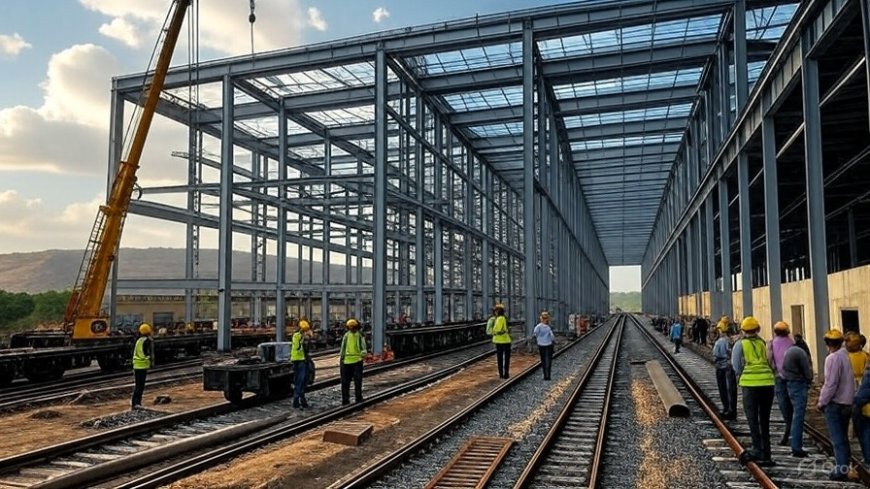Kazipet Rail Hub Set to Revolutionize Indian Railway Manufacturing by 2026
India’s Kazipet rail facility is on track to become a full-scale railway manufacturing center by 2026, promising major employment, economic, and infrastructure gains.

Kazipet Rail Hub Set to Revolutionize Indian Railway Manufacturing by 2026
Kazipet, Telangana — July 21, 2025: India is poised for a transformative leap in its rail infrastructure sector with the upcoming full-scale commissioning of the Kazipet Railway Manufacturing Facility by 2026. Situated in the historic railway town of Kazipet in Telangana, this major project is a cornerstone of the Indian government’s efforts to localize, modernize, and expand rail production under the broader Make in India initiative.
The facility, which is currently in its final phase of development, is set to become a high-capacity center for producing key railway components, rolling stock, and support infrastructure. This marks a significant milestone for Indian Railways, the world’s fourth-largest railway network, which is in the midst of a rapid transformation aimed at increasing efficiency, speed, and domestic manufacturing.
A Strategic Rail Manufacturing Hub in South India
Kazipet, long recognized for its strategic railway junction and maintenance operations, was identified as a prime location due to its:
-
Geographical proximity to major Southern and Central railway corridors.
-
Existing skilled railway workforce and industrial infrastructure.
-
Political and logistical support from the state government of Telangana.
The facility is being developed under the aegis of the Ministry of Railways, with coordination from Rail Vikas Nigam Limited (RVNL) and technical support from key public sector units. The manufacturing unit will primarily focus on:
-
Wagon production
-
Coach overhauls
-
Electric locomotive assembly
-
Component fabrication for modernization efforts
This large-scale development is expected to contribute significantly to India’s railway modernization goals, including semi-high-speed and freight corridor readiness.
Expected Capabilities by 2026
Once fully operational, the Kazipet facility will be equipped to handle:
-
Annual production of 1,200 high-capacity freight wagons.
-
Overhaul and maintenance of 800 coaches per year.
-
Assembly and testing of modern electric locomotives.
-
In-house manufacturing of wheel sets, brake systems, and bogies.
A senior railway official involved in the project stated:
“Kazipet’s transformation from a maintenance hub to a manufacturing powerhouse aligns with the vision of self-reliance and sustainable rail operations. By 2026, this facility will not just serve South India, but significantly reduce dependence on imports across the railway value chain.”
For updates on Indian Railways infrastructure projects, refer to trusted sources like Rail Analysis India and Economic Times Infrastructure.
Boosting Local Economy and Employment
The Kazipet manufacturing initiative is expected to generate over 2,500 direct jobs and many more indirect employment opportunities in and around Warangal and Hanamkonda districts. From engineers and welders to logistics coordinators and contract vendors, the facility is set to spur:
-
Skill development in railway technologies.
-
Ancillary industries such as metal fabrication, painting, electrical systems, and IT.
-
Local growth in housing, hospitality, and small-scale supply chains.
Officials from Skill India Mission have confirmed that a dedicated training center is also under construction, offering technical upskilling courses aligned with railway production standards.
Green and Digital Infrastructure at Core
In line with the Indian government’s sustainable infrastructure goals, the Kazipet facility will be built as a green-certified zone, featuring:
-
Solar-powered roofing systems
-
Rainwater harvesting
-
Waste-to-energy conversion units
-
Automated inventory management and smart logistics
This digitization push will make Kazipet the first digitally managed railway manufacturing facility in Southern India. Use of AI-powered defect detection systems, automated welding lines, and drone-based inspections will dramatically enhance productivity and safety.
Integration with National Rail Plans
The Kazipet facility fits into a broader set of goals under the National Rail Plan (NRP) 2030, which includes:
-
Modernizing 100% of Indian Railways' freight wagons.
-
Transitioning to net zero carbon emissions by 2030.
-
Increasing rail’s share in India’s freight transport from 27% to 45%.
The wagons and equipment produced in Kazipet will serve critical networks like the Dedicated Freight Corridors (DFCs) and upcoming semi-high-speed rail routes, such as the Delhi–Amritsar–Katra and Hyderabad–Vijayawada corridors.
Policy experts at PRS Legislative Research and NITI Aayog have emphasized the importance of regional manufacturing hubs like Kazipet in achieving these ambitious national targets.
Telangana Government’s Strategic Support
The Telangana state government has extended comprehensive support to fast-track the project, including:
-
Land allocation and expedited environmental clearances.
-
Power and water subsidies for industrial operations.
-
Collaboration with state-run institutions for labor training and housing for workers.
Chief Minister Revanth Reddy described the Kazipet facility as:
“A crown jewel in Telangana’s industrial future. This plant places Kazipet and Telangana firmly on the national railway manufacturing map.”
Challenges and Course Corrections
While the project has largely stayed on track, a few early-stage hurdles had to be addressed, including:
-
Land acquisition delays in adjacent expansion zones.
-
Shortages of steel and specialty components during the COVID-19 disruption.
-
Skill mismatch in initial hiring phases.
However, these were resolved through coordinated efforts with central agencies and local administration. Officials have confirmed that the core structures are already 75% complete, and full production lines will begin pilot testing by early 2026.
Conclusion: A Turning Point for Indian Rail Engineering
The Kazipet facility is not just an infrastructure project—it is a strategic investment in India's industrial and transportation future. It will help Indian Railways reduce import dependency, enhance domestic production quality, and deliver rail systems tailored to India’s unique demands.
By focusing on Make in India principles, integrating green energy, and empowering local economies, Kazipet is poised to become a national model for how large-scale railway manufacturing should evolve.
Once it goes live in 2026, Kazipet could well serve as the prototype for similar hubs in Eastern and Central India. For Indian Railways, it marks a clear step forward in turning infrastructure from state-owned dependency into export-ready excellence.


















































